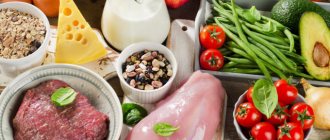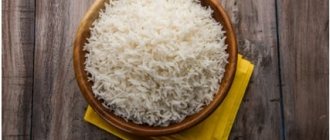Calorie table for different types of flour
The calorie content of flour and BJU (proteins/fats/carbohydrates) varies depending on the type of product.
To select low-fat flour that is suitable for diabetics or obese patients, it is necessary to consider the beneficial properties
Common types with nutritional value:
| View | Calories (100 g) | BZHU (100 g) |
| Wheat (highest grade) | 339 | 11/1,4/70 |
| Wheat (coarse grind) | 312 | 11/1,5/65 |
| Wheat (whole grain) | 302 | 13/1,5/58 |
| Rye | 295 | 12/2/35 |
| Coconut | 456 | 20/15/60 |
| Almond | 606 | 26/54,5/13 |
| Rice | 365 | 6/1,5/85 |
| Corn | 325 | 7/2/76 |
| Oatmeal | 375 | 12/6/60 |
| Barley | 300 | 9/1/60 |
| Linen | 273 | 36/10/5 |
| Chickpeas | 389 | 22,2/7/58 |
| Buckwheat | 349 | 13,8/1/,72 |
| Pea | 292 | 9/1,7/61 |
| Pumpkin | 301 | 33/9/22 |
| Spelled | 150 | 12,/0,7/25 |
| Cheremukhovaya | 120 | 7,8/0/21 |
| Amaranth | 293 | 9/1,7/60,5 |
| Sesame | 468 | 46/12/30 |
Low-calorie varieties are bird cherry and spelled. If you are more used to wheat, it is recommended to use the whole grain variety.
What flour is good for diabetics and those losing weight?
To choose low-fat flour suitable for patients with diabetes or obesity, you need to consider the beneficial properties:
- soy – contains protein, strengthens bone and cartilage tissue, muscle corset;
- corn - contains vitamins A and E, improves bile flow, stabilizes the gastrointestinal tract, makes the vessels and arteries of the heart muscle strong and durable;
- buckwheat – stabilizes the amount of glucose in the blood;
- oatmeal – lowers cholesterol, normalizes stomach function;
- flaxseed – cleanses of decay products, toxins, starts accelerated food processing, promotes weight loss;
- coconut – accelerates the breakdown of fat cells, gives a feeling of fullness and suppresses hunger, fights constipation and stabilizes the gastrointestinal tract;
- almond – lowers cholesterol, triggers the body’s natural production of insulin, cleanses the kidneys, protects blood vessels, prevents the absorption and deposition of carbohydrates.
Advice! It is recommended to exclude wheat variety from the diet, replacing it with whole grain bran.
What foods should you limit?
Diabetics should avoid white flour
Diabetics should avoid all white flour as it contains a lot of calories. From a dietary point of view, this variety is considered the least useful, since it inhibits digestion and complicates the digestion of food.
Note! Despite the lower calorie content of whole grain flour, it contains the same starch. Therefore, even limiting it in the daily diet will lead to increased blood sugar and weight gain.
Rice flour, although it contains many microelements, is not considered healthy due to the presence of dietary fiber. Therefore, its amount in the diet must be reduced to a minimum, replacing it with species that are valuable from the point of view of healthy nutrition.
How to use rice flour
How to use rice flour? Use it for cooking! You can add it to any baked goods (preferably dietary ones!). Products made from such flour are no less tasty and soft than those made from wheat flour - you may not even feel the difference. You can use it to make cakes, pancakes, muffins, pies, and make homemade dumplings.
However, you won’t be able to bake bread with rice flour alone - yeast dough needs gluten, which this product does not contain. For such baking, rice flour is mixed with any other flour that contains gluten. But if you follow a dietary regime, it is advisable to completely abandon yeast baked goods.
It is also added to dishes to keep their shape (for example, cutlets). Or used as a thickener in homemade sauces. Flour from these cereals is such a safe product that it is even used instead of a thickener in infant formula.
Remember that any flour should be consumed in moderation - be it wheat, rice or whole grain. This is a very high-calorie and starchy product, the uncontrolled consumption of which will lead to weight gain. This is especially true for baking - it should be reduced in the diet of those losing weight. It is not advisable to consume more than 80 g of rice flour (in its pure form) per meal.
Interesting! You can make rice flour yourself - the preparation process does not take much time. You just need to prepare raw grains of white or brown rice, rinse them and dry them completely on paper. Then grind the rice in a coffee grinder or blender until it becomes a powder. It is advisable to store flour for no longer than 5 months.
Now that we have understood the benefits and harms of rice flour for weight loss, we can draw a final conclusion - such flour will be a healthier alternative to wheat flour and, if consumed in moderation, will not harm your figure. Therefore, even on a diet and proper nutrition, you can sometimes treat yourself to healthy and tasty pastries!
Interesting: Diet baking for weight loss
Write in the comments: Do you use rice flour for cooking?
Why is white wheat flour harmful?
Wheat flour does more harm than good. Regardless of the variety, it does not exclude dietary fiber, affects health and leads to weight gain.
This simple, refined product contains gluten, a protein derivative of gluten, which glues the contents of cereals together and causes diseases.
Note! With regular consumption of dough made from premium flour, people may eventually develop celiac disease, that is, gluten intolerance, for this reason it is important to reduce the frequency of their use and monitor nutrition.
The gluten content will depend on the variety and grinding of the product: usually it is higher in premium varieties.
Flour in proper nutrition
Many people have heard since childhood that a love of flour leads to excess weight. Does it actually cause weight gain and slow down weight loss? Experts believe that completely avoiding flour is harmful to the body. This opinion is supported by nutritionists; they are confident that it is not worth completely excluding the product from the diet, it is enough to choose the right variety. It’s quite possible to eat delicious baked goods and not gain weight!
Which flour is the lowest in calories and healthiest?
How to replace white wheat flour?
A beneficial solution for the daily menu of diabetics is the complete exclusion of the product, but often most patients are not capable of such sacrifices.
Different types of flour
An alternative in this case would be to replace wheat flour with healthy types:
- spelled;
- spelt;
- coarse buckwheat;
- bran;
- cereals;
- airy cookies and bread.
Instead of traditional white flour, it is recommended to purchase coarsely ground wallpaper, which is suitable for baking baked goods and unsweetened cookies.
The healthiest flour is other types
Flour itself is high in calories, so people with diabetes or overweight are advised to consume a strictly limited amount of it per week.
The best option is considered to be up to 500 kcal per week. Useful varieties that are preferable to use instead of the classic type are buckwheat, spelled, oatmeal, rye and others.
Spelled or spelt
Spelled flour
One of the purest and lightest whole grain varieties of the product. Made from wheat germ, it is rich in healthy protein and nutritious fiber.
The proteins in its composition differ in structure, are absorbed faster and do not provoke an allergic reaction. It is suitable for diabetics, allergy sufferers and those with complete gluten intolerance.
Peeled rye or wallpaper flour
Rye flour
is considered the coarsest and most sticky and does not undergo deep processing. Rye flour contains whole parts of the grains along with the shells.
Therefore, this variety is considered more beneficial for the body, it is digested and absorbed faster without complications, does not inhibit metabolism, and helps cleanse the body.
The content of minerals and trace elements in it is increased. A suitable option for baking homemade rye bread.
Coarse wheat wallpaper
This variety is different from the usual white flour; it is obtained from purified, natural whole wheat grains.
Note! There are 3 factories on the territory of the Russian Federation that produce flour of this type: the Solnechny agricultural complex, Belovodye and Diamant. When making a purchase, make sure that the packaging has a special eco-test sign.
This cooking method retains all the valuable vitamins and minerals found in regular flour, but at the same time reduces the gluten and starch content. Suitable for homemade lean and sweet baking.
Buckwheat flour
Buckwheat flour
A dietary option for those who cannot do without baked goods. Made from buckwheat grain. Unlike other varieties, it contains the lowest percentage of starch and a fairly high content of vitamins.
Suitable for baking muffins, buns, pancakes and sweet pastries.
Oat flour
Oatmeal
has a pleasant taste and contains many nutritional elements. Thanks to its excellent taste and combination with other ingredients, it can easily replace the usual white flour.
Suitable for baking muffins, sweets, pancakes and many dietary dishes.
Corn flour
Corn flour
A natural source of protein, grains and valuable dietary fiber.
It saturates the body and has a beneficial effect on weight loss, allows you to cleanse the body of toxins, remove excess water, and speed up metabolism.
It does not contain gluten, so it is suitable for diabetics, allergy sufferers, overweight people and those suffering from celiac disease.
Flaxseed flour
This variety contains up to 30% fiber and is a source of healthy dietary fiber. Therefore, its use cleanses the body and stabilizes the functioning of the digestive organs and intestines.
This composition makes this variety one of the best for a healthy diet and getting rid of extra pounds.
Rice flour
It is rich in calcium, fluorine, and folic acid, so consuming rice flour will help gently cleanse the intestines and improve digestion.
Disadvantage: Excessive consumption leads to constipation. Therefore, it must be consumed in moderation.
Benefits and harms of the product
Any flour carries a lot of useful substances for the body. It is worth listing the main ones:
- 100 g of product contains so much iron that it covers the daily requirement by 32%. And iron is involved in providing all cells of the body with oxygen. The fact is that iron is the leading component of the hemoglobin molecule - a protein of red blood cells (erythrocytes), which binds to oxygen and transports it in bound form to all tissues of the body.
- With bread for breakfast, lunch and dinner we get 10% of our daily calcium requirement.
- Flour contains vitamins B and PP. And they are necessary for the normal functioning of the nervous, muscular, and digestive systems.
- Flour has Omega-3 and 6 fatty acids, which are needed for beautiful hair, nails, skin, and well-being. In addition, these substances can reduce the concentration of bad cholesterol in the body, which disrupts the functioning of the cardiovascular system.
WHO recommends that everyone consume at least 25 g of bread per day. But it is better that these are products made from wholemeal flour. It is the most useful, it contains a lot of fiber.
Expert opinion
Evgeniy Kislitsa
Practicing surgeon. Certified massage master. Two-time vice-champion and heavyweight champion of regional kettlebell lifting competitions.
Fiber is a hard-to-digest dietary fiber. The bottom line is that it is little susceptible to the influence of food enzymes, which is why it is poorly digested. The benefits of fiber are pronounced for the intestines. As it passes through the intestines, it affects its walls, thereby increasing their tone. And this leads to improved motility (periodic rhythmic contractions of the intestinal wall) of the organ, which improves digestion. Also, adequate fiber intake is a reliable method of preventing constipation. In addition to the above, fiber has a beneficial effect on intestinal microflora. The fact is that both beneficial and harmful bacteria live in the intestinal lumen. Fiber, passing through the intestines, “washes out” harmful bacteria from it. After which it becomes easier for beneficial microorganisms to reproduce (after all, the population of their competitors decreases). Thanks to this property, fiber is not only able to normalize digestion in the intestines, but also prevent many diseases of the organ. In medicine, due to this property, fiber is used to treat dysbiosis and a number of diseases of the digestive system. In addition, fiber affects the stretch receptors of the stomach wall, due to which it allows you to get full faster and not feel hungry for a long time.
You may also be interested in: Healthy Bread Recipe
Unfortunately, there is also harm, but it is not caused by the product itself, but by the amount of use.
What does it consist of:
- High calorie content, so a large amount of bread is dangerous for your figure. Especially when it comes to muffins and cakes.
- Contains vegetable gluten protein, which can cause bloating and diarrhea in particularly sensitive people. With long-term gluten consumption, people who are sensitive to it can develop severe inflammatory bowel disease. And for those suffering from celiac disease, long-term consumption of foods containing gluten can lead to severe organic intestinal lesions that are difficult to treat.
White bread is also of little use, but can only cause flatulence and belching. Moreover, it is the most high-calorie of all types of bread.
Important! There is an opinion that modern industrial yeast used in baking bread is harmful to the body. In fact, they die at temperatures above 60 degrees. And when baking bread in an oven at 200 degrees, not a trace of microorganisms remains.
Be sure to check out:
Is it possible to eat corn while on a diet: benefits and harms? Get a complete set of proteins, fats and carbohydrates from Doshirak dietary products on a diet: is it possible to eat fast food products? Is it possible to eat soy sauce while on a diet: all the myths and truth











